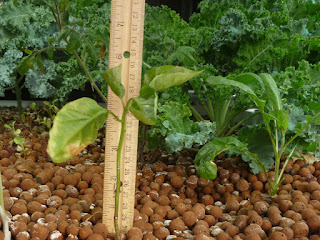The plants:
Tomato - Patio Princess Hybrid from Burpee, grown from seeds
Bell Pepper - Purple Beauty from Botanical Interests, grown from seeds
The soil in bag media:
2 parts coconut coir (shredded coconut shells)
1 part vermicompost (worm casting)
small amount of powered mycocillium inoculate
The bag:
5 gallon Aquapouch from the Aquaponics Source store in Longmont
Results to date:
Day 1 - 06/09/2015 planted seeds using Rapid Rooter plugs into the seed "barge". I decided to float the seed tray in the fish tank as many folks recommend warming the seed tray to about 70F and that just happens to be the current temperature in the fish tank. Bonus: the fish like to hide underneath the tray, I think it makes them feel safe.
Week 17 10/11/2015 - plants in Aquapouch much larger than plants in grow bed media
Bell Peppers
Tomatoes
Dramatic difference, especially for the tomatoes. The bell peppers look unhappy in either media. Will have to investigate what growing conditions better suit the bell peppers.
The kale took forever to sprout, but when the seedling finally took off, wow, it's a great grower. We have been eating kale for several weeks now off this batch:
We have gotten a few squash from this plant, maybe only 3 so far. I'm letting this one grow to see just how big it will get. It's about 4" long right now.
Also, I'm letting the basil go to seed just for fun:
The little poopers that fuel the whole system:
Right now, we have:
15 Comet Goldfish (they started life as feeder fish) 2-3" each
2 fat Fantails 3-4" each
3 Koi 5-6" each
2 Butterfly Koi 6" each
and that's still not enough. Regular water tests show 0 ammonia, nitrite and nitrates which is fine for the fish, but I would like to see some nitrates register on the tests as that is what the plants need to "eat". Next spring we will get some Tilapia, until then I'm just feeding the fish 4-6 times per day to maximize growth (and poop).



















































